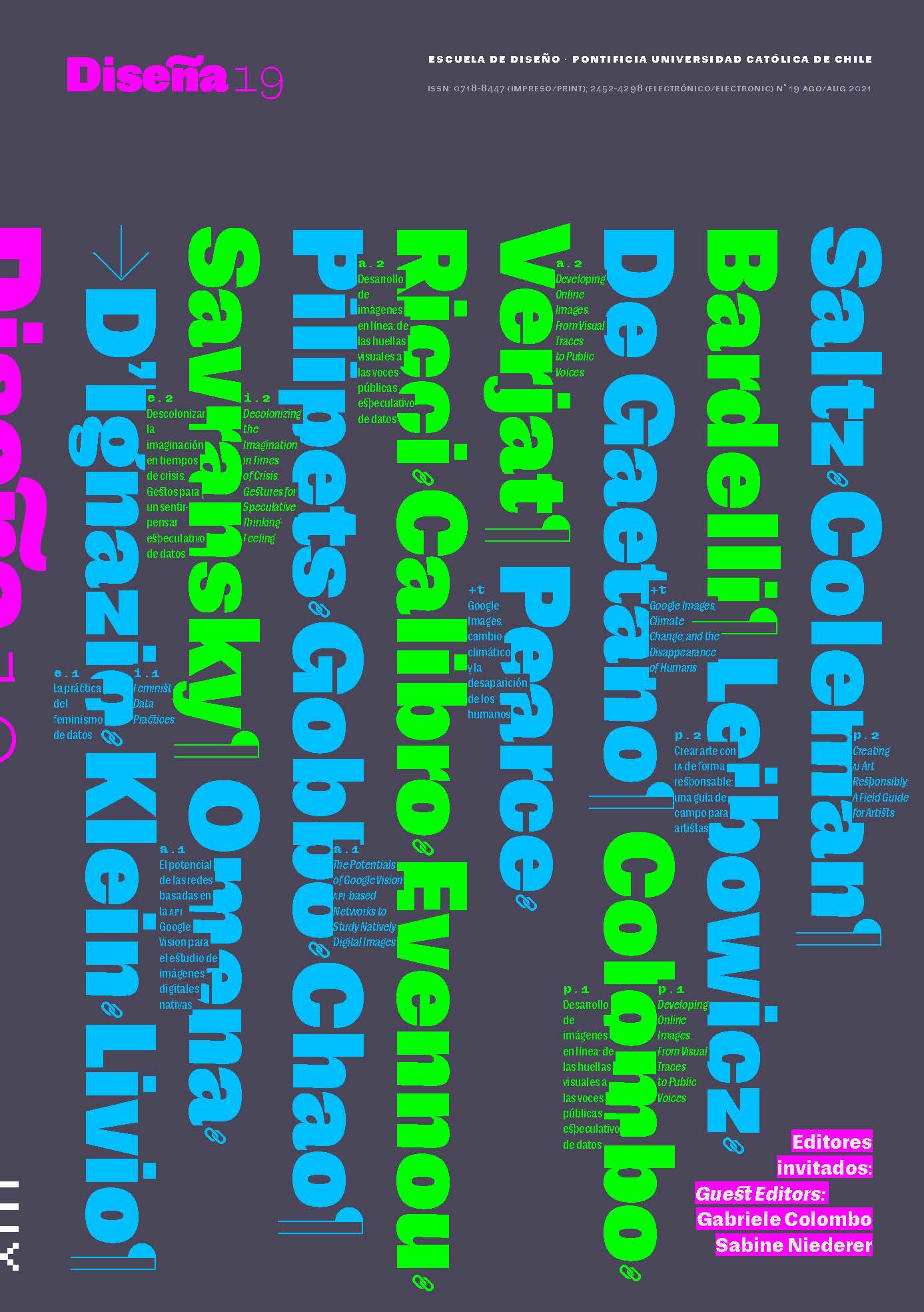Data-Driven Curated Video Catalogs: Republishing Video Footage
Main Article Content
Abstract
This project illustrates data-driven curated video catalogs as an approach for the analysis of video footage. Having rich and diverse collections of videos as inputs, data-driven catalogs seek to identify common objects and reorganize them into thematic clusters displayed in a video format. The technique takes inspiration from two scientific practices (core sampling and light diffraction) and two publishing formats (supercuts and visual catalogs). Data-driven curated video catalogs are used to republish a collection of found footage of 2019 Veniceʼs high water that devastated the city in an unprecedented way. Starting from an editorial selection of footage culled from YouTube, various algorithmic processes are used to demarcate and reorganize the material into thematic video series (people, boats, and birds). The resulting video catalogs support a type of visual analysis that goes beyond traditional forms of measurement while, at the same time, carrying an expressive power.
Downloads
Article Details

This work is licensed under a Creative Commons Attribution-ShareAlike 4.0 International license.
COPYRIGHT NOTICE
All contents of this electronic edition are distributed under the Creative Commons license of "Attribution-ShareAlike 4.0 Internacional" (CC-BY-SA). Any total or partial reproduction of the material must mention its origin.
The rights of the published images belong to their authors, who grant to Diseña the license for its use. The management of the permits and the authorization of the publication of the images (or of any material) that contains copyright and its consequent rights of reproduction in this publication is the sole responsibility of the authors of the articles.
References
Ahmed, S. (2017, May 1). The Effort to Transform: Intellectual Legacies of Stuart Hall. Feministkilljoys. https://feministkilljoys.com/2017/05/01/the-effort-to-transform-intellectual-legacies-of-stuart-hall/
Bochkovskiy, A., Wang, C.-Y., & Liao, H.-Y. M. (2020). YOLOv4: Optimal Speed and Accuracy of Object Detection. Association for Computing Machinery ArXiv, arXiv:2004.10934. https://arxiv.org/abs/2004.10934
Clarifai. (2017, October 12). Search Images by Visual Similarity with the Clarifai API. https://www.clarifai.com/blog/search-images-by-visual-similarity-with-the-clarifai-api
Colombo, G. (2019). Studying Digital Images in Groups: The Folder of Images. In L. Rampino & I. Mariani (Eds.), Advancements in Design Research: 11 PhD Theses on Design as We Do in Polimi (pp. 185–195). Franco Angeli Open Access.
Diffraction grating. (2021). In Wikipedia. https://en.wikipedia.org/w/index.php?title=Diffraction_grating&oldid=1036649242
Eco, U. (2009). The Infinity of Lists: An Illustrated Essay (A. McEwen, Trans.). Rizzoli.
Hanrahan, H. (2011). It’s showtime! [Video]. https://www.youtube.com/watch?v=LUapZhcsdx8
Juzwiak, R. (2008). I’m Not Here to Make Friends! [Video]. https://www.youtube.com/watch?v=w536Alnon24
Krizhevsky, A., Sutskever, I., & Hinton, G. E. (2017). ImageNet Classification with Deep Convolutional Neural Networks. Communications of the ACM, 60(6), 84–90. https://doi.org/10.1145/3065386
Maggot3560. (2006). Scarface F Word [Video]. https://www.youtube.com/watch?v=Ft07LYRjFwM
Marres, N. (2020). For a Situational Analytics: An Interpretative Methodology for the Study of Situations in Computational Settings. Big Data & Society, 7(2), 2053951720949571. https://doi.org/10.1177/2053951720949571
McInnes, L., Healy, J., & Melville, J. (2020). UMAP: Uniform Manifold Approximation and Projection for Dimension Reduction. Association for Computing Machinery ArXiv, arXiv:1802.03426v3. https://arxiv.org/abs/1802.03426v3
Noble, O. (2010). Every Arnold Scream from Every Arnold Movie [Video]. https://www.youtube.com/watch?v=5aLR-8c11ms
Odell, J. (2009). Satellite Collections. https://www.jennyodell.com/satellite.html
Odell, J. (2015). Peripheral Landscapes: People, Gods, and Flora/Fauna. https://www.jennyodell.com/peripheral-landscapes.html
Raftery, B. (2018, August 30). I’m Not Here to Make Friends: The Rise and Fall of the Supercut Video. Wired. https://www.wired.com/story/supercut-video-rise-and-fall/
Sze. (2018). Sarah Sze: Infinite Generation [Interview]. (L. Neri, Interviewer). Gagosian Quarterly, (Winter). https://gagosian.com/quarterly/2019/10/08/interview-sarah-sze-infinite-generation/
Treccani Enciclopedia. (n.d.). Carotaggio. In Treccani Enciclopedia online. Istituto della Enciclopedia Italiana fondata da Giovanni Treccani. Retrieved November 7, 2020, from https://www.treccani.it/enciclopedia/carotaggio
Van der Maaten, L., & Hinton, G. (2008). Visualizing Data using t-SNE. Journal of Machine Learning Research, 9(86), 2579–2605.
Veca, A. (2011). Figure di argomentazione. In V. Bucchetti (Ed.), Altre figure. Intorno alle figure di argomentazione (pp. 17–61). Franco Angeli.
VICE News. (2018). Trump Talk: All Our Best Mashups in One Video [Video]. https://www.youtube.com/watch?v=2i4JxWkSYzU
Zabriskie, C. (2008). Previously on Lost: What? [Video]. https://www.youtube.com/watch?v=GcatQSyRK6c

